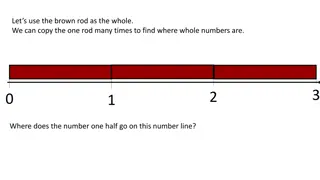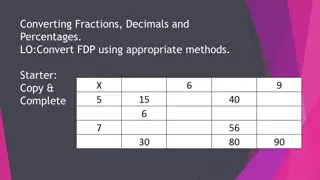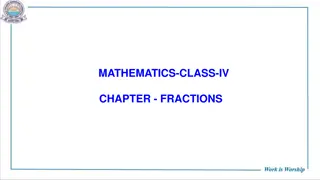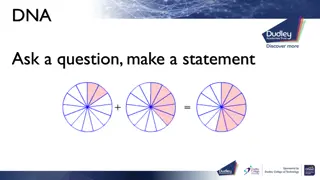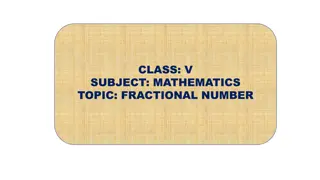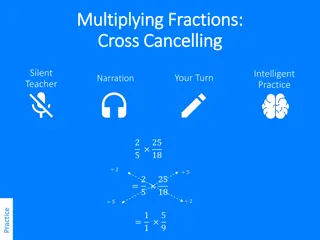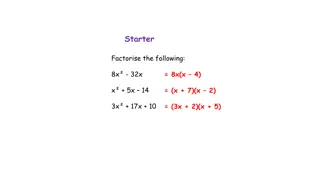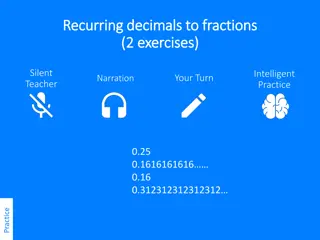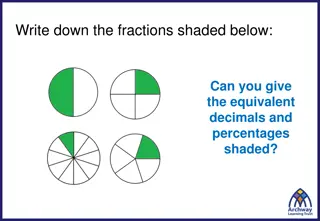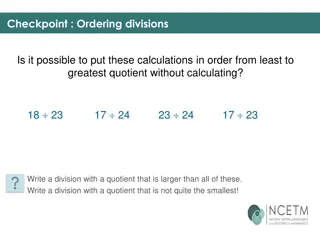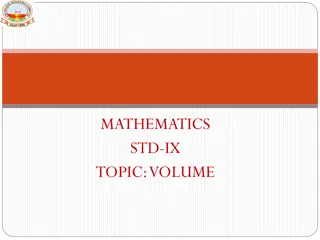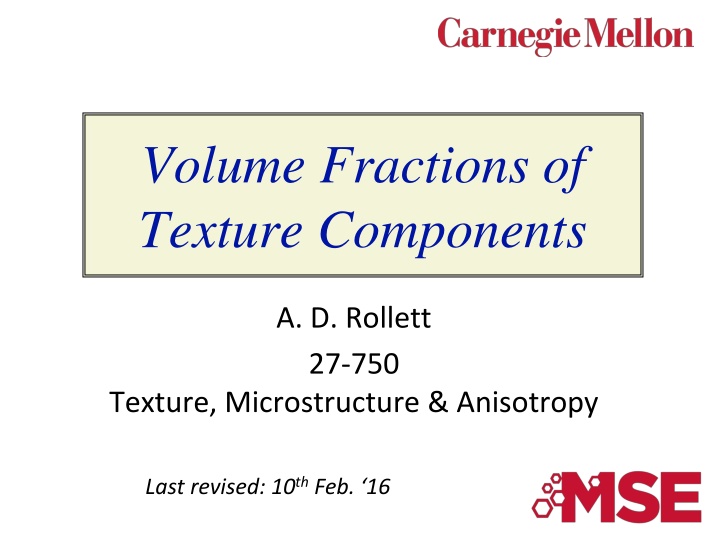
Intensity Calculation from Volume Fractions in Texture Analysis
Learn how to calculate intensities in texture analysis from volume fractions. Understand the definitions of volume fractions, capture angles, and misorientations. Explore the importance of symmetry and different components in random textures.
Download Presentation

Please find below an Image/Link to download the presentation.
The content on the website is provided AS IS for your information and personal use only. It may not be sold, licensed, or shared on other websites without obtaining consent from the author. If you encounter any issues during the download, it is possible that the publisher has removed the file from their server.
You are allowed to download the files provided on this website for personal or commercial use, subject to the condition that they are used lawfully. All files are the property of their respective owners.
The content on the website is provided AS IS for your information and personal use only. It may not be sold, licensed, or shared on other websites without obtaining consent from the author.
E N D
Presentation Transcript
Volume Fractions of Texture Components A. D. Rollett 27-750 Texture, Microstructure & Anisotropy Last revised: 10th Feb. 16
Lecture Objectives 2 Explain how to compute intensities in a discrete OD from counts of grains, points or volumes. Define volume fraction as the fraction of material whose orientation lies within a specified range of orientations. Explain how to calculate volume fractions given a discrete orientation distribution. Describe the calculation of orientation distance as a subset of the calculation of misorientations. Also discuss how to apply symmetry, and some of the pitfalls. Illustrate the binning scheme used for 5-parameter grain boundary description, as part of the discussion of how to obtain MRD values for specific examples.
Notation 3 g - orientation f(g) - orientation distribution O - symmetry operator O432 - 432 point group OC - crystal symmetry operator OS - sample symmetry operator tr - trace of a matrix g - misorientation Vf physical volume fraction of grain, material, orientation - Euler angles - Volume of orientation space, increment of volume popLA preferred orientation package Los Alamos, a software package written in the early 1990s to analyze texture data, based on the DOS operating system.
In Class Questions 4 How do we compute intensities from volume fractions? What is the difference between cell-edge and cell-centered coordinates? What do we mean by the volume fraction of a texture component? How do we compute the volume fraction of a component? What is a capture angle or tolerance angle or capture radius? What is a partition map? Why is the density of randomly chosen orientations (in Euler space) not uniform? Describe two ways to compute orientation distance. Why is misorientation useful for computing orientation distance? How do we apply symmetry to compute misorientation? Why do different components (e.g. cube vs. S) have different volume fractions in a random texture?
Intensity from Volume Fractions 5 Objective: given information on volume fractions (e.g. numbers of grains of a given orientation), how do we calculate the intensity in the OD? General relationships: Integrate odf to get volume fraction: Differentiate volume fraction to get odf : Reminder on units of the OD: the way that normalization is performed means that the units of the OD are Multiples of a Random Density (MRD). If there is no texture or preferred orientation then the value of f is one everywhere. Note that the formulae given here differ from those in Bunge (who has very little to say about this topic). His correspond to a strict probability density formulation.
6 Discrete vs. Continuous Distributions These notes emphasize the use of discrete distributions for obtaining volume fractions. If a continuous distribution is available, e.g., from fitting generalized spherical harmonics (from the series expansion method) then other ways of integrating over orientation space are used. Brief notes about how to use this approach are provided at the end. For data obtained as discrete points, e.g., from EBSD maps, performing calculations directly on the data makes the least assumptions about the material. On the other hand, prior knowledge may provide a justification for using a particular fitted function.
7 Intensity from Vf , contd. For each cell, we assign an intensity equal to the volume fraction in that cell, V, divided by the volume of orientation space associated with that cell, and multiplied by the total volume of orientation space . If we have points with equal area or volume (e.g. EBSD data) the volume fraction, Vi, is simply the number of points in the ith cell, ni, divided by the total number of points, N: Vi=ni/N. For 5x5x5 discretization in a 90x90x90 space, we particularize to: Vf(g)=18100 2 f(g)=1 V dg DWg DVf 25 2cos F-2.5 [ f(g)sinFdFdj1dj2 =WDVf dV(g) =8100 2 ( ) ]-cos F+2.5 [ ]
Discrete OD 8 Normalization also required for discrete OD Normalization depends on the size of the sub-space of orientation, and on the measure used (radians versus degrees). Sum the intensities over all the cells. 0 1 2 , 0 , 0 2 2 1= = 8p2 f2 Df1Df2cos Fi- -DF - -cos Fi+ +DF 1 F ( ( ) ) f f1,Fi,f2 2 2 f1 0 1 90 , 0 90 , 0 2 90 1 8100 f2 Df1Df2cos Fi- -DF - -cos Fi+ +DF F ( ( ) ) 1= = f f1,Fi,f2 2 2 f1
Volume fraction calculations 9 Choice of cell size determines size of the volume increment, which depends on the value of the second angle ( or ). Some grids start at the specified value. More typical for the specified value to be in the center of the cell. popLA: grids are cell-centered.
10 Discrete ODs dA=sin d d 1: A= (cos ) 1 Cell edge discretization Each layer: = A 2 = 90( ) 1 Total: = 8100( )2 0 10 20 90 80 0 f(10,0,30) 10 20 = f(10,10,30) Section at 2= 30 2=10 80 f(10,80,30) 90 1 =
dA=sindd1: A= (cos ) 1 Centered Cells Different treatment of end and corner cells to exclude volume outside the subspace 11 1 90 0 10 20 0 = f(10,0,30) = . 10 20 f(10,10,30) 80 f(10,90,30) 90 1 = 1 = Cell centered discretization
12 Discrete orientation information Typical text data.ANG file from TSL EBSD system (e.g. SmallIN100/Slice_1.ang available in SmallIN100.zip): # WorkDirectory # OIMDirectory ... # 4.724 0.234 4.904 0.500 0.866 1.0 1.000 0 0 4.491 0.024 5.132 7.500 0.866 1.0 1.000 0 0 4.932 0.040 4.698 19.500 0.866 1.0 1.000 0 0 4.491 0.024 5.132 20.500 0.866 1.0 1.000 0 0 4.491 0.024 5.132 21.500 0.866 1.0 1.000 0 0 4.932 0.040 4.698 22.500 0.866 1.0 1.000 0 0 4.932 0.040 4.698 23.500 0.866 1.0 1.000 0 0 4.932 0.040 4.698 24.500 0.866 1.0 1.000 0 0 (Euler angles, radians) (spatial coordinates, microns) /usr/OIM/rollett /usr/OIM Each dataset may have millions of points 1 2 x y
Binning individual orientations in a discrete OD 1 13 0 10 20 90 80 0 10 20 = Section at 2= 30 individual orientation 80 90 1 =
14 Example of random orientation distribution in Euler space [Bunge] Note the smaller densities of points (arbitrary scale) near = 0 . When converted to intensities, however, then the result is a uniform, constant value of the OD (because of the effect of the volume element size,sin d d d ). If a material had randomly oriented grains all of the same size then this is how they would appear, as individual points in orientation space.
OD from discrete points: pseudo-code 15 1. Compute the volume of the chosen orientation space, e.g. Euler space, e.g. 90 x 90 x 90 = dg = 8100 2. Also compute the volume of each cell; in this case d ( 1, 2) = (cos ) 1 2 Bin each orientation into a cell in the OD Sum number (or weight, if each orientation represents a different physical volume) in each cell Divide the number (or physical volume) in each cell by the total number of grains (or total physical volume) to obtain Vf Convert from Vf to f(g): f(g) =Vf* /d = 8100 Vf / { (cos ) 1 2} 2. 3. 4. 5. = dg d =cell volume
Discrete OD from points 16 The same Vf near =0 will have much larger f(g) than cells near =90 . Unless large number (>104, texture dependent) of grains are measured, the resulting OD will be noisy, i.e. large variations in intensity between cells. Typically, smoothing is used to facilitate presentation of results: always do this last and as a visual aid only! An alternative to smoothing an ODF plot is to replace individual points by Gaussians and then evaluate the texture. This is particularly helpful (and commonly applied) when performing a series expansion fit to a set of individual orientation measurements, such as OIM data.
Volume fraction calculation 17 In its simplest form: sum up the intensities multiplied by the value of the volume increment (invariant measure) for each cell. Check that when you compute this sum for the entire space the result is equal to one (else the normalization is not correct).
Simple results 18 cos (g) ( ) Intensity (MRD) What if all the orientations/grains/sets_of_Euler_angles fall in one cell? Answer: the intensity (in units of Multiples of a Random Density, MRD) in that cell depends on its location in the space (assuming uniformly divided space by angle), and the intensity in all other cells is exactly zero. Example: cell-edge coordinates with 10 increments in a 90x90x90 space (total volume, = 8100 ( 2); each cell has volume (g) =100x cos( )). Note that the sum of the second column is one, as it must be for the integral of sin( ) over the interval [0.. /2]. More exactly: f(g) = (g) The magnitude of the peak depends on the cell size in relation to the volume, not on the measure (degrees versus radians). 0 0.0152 5331 10 0.0451 1795 20 0.0737 1100 30 0.1 810 40 0.1233 657 50 0.1428 567 60 0.1580 512 70 0.1684 481 80 0.1736 466
Simple results: 2 19 ( ) cos (g) Intensity in Cell (MRD) f(g) elsewhere (10-5 MRD) What if all, say, 9/10ths of the grains fall in one cell and the rest are randomly distributed? Answer: the intensity in that cell once again depends on its location in the space (assuming uniformly divided space by angle), and the intensity in all other cells is fixed at 0.1/{remaining volume}, where the remaining volume is the total volume minus the volume of the individual cell that contains 9/10ths of the volume. Example: cell-edge coordinates with 10 increments in a 90x90x90 space (total volume = 8100; each cell has volume 100x cos( )). Note that the sum of the second column is one. More exactly (in the single cell): f(g) = 0.9 (g), - peak or elsewhere, since f(g) = f(g) = 0.1 / ( (g)) - random 0 0.0152 4779 0.10002 10 0.0451 1615 0.10006 20 0.0737 990 0.10009 30 0.1 729 0.10012 40 0.1233 591 0.10015 50 0.1428 510 0.10017 60 0.1580 461 0.10019 70 0.1684 433 0.10020 80 0.1736 420 0.10021
Grain Boundary Space 20 As a preview to dealing with grain boundaries, we explain the binning scheme and show how to compute intensities and expected area fractions. A grain boundary requires five (5) macroscopic parameters to describe its crystallographic character (which ignores translational parameters at the atomic scale). Generally, it is convenient to separate these parameters into the disorientation and the normal of the boundary plane. For the purposes of this lecture, assume that the disorientation is the difference in orientation across the boundary, reduced to a fundamental zone (FZ). Assume that the normal is a unit vector described by two spherical angles, which can be referred to either one of the two crystal lattices (orientations). Assume a binning scheme in which the disorientation is expressed as Euler angles thus ( 1, cos( ), 2); each dimension is divided into equal size cells. The use of the cosine provides cells of equal volume. We bin the normal according to ( , cos( )), where alpha is the co-latitude and beta the longitude. For cubic materials, we can use a 90 x90 x90 space for disorientation (which contains multiple copies of the FZ) and a 90 x360 space for the normal (which has only one copy of the FZ).
21 Area Fractions of Grain Boundaries A reasonable discretization uses 9 intervals (cells) in all dimensions except we use 36 for the longitude of the normal. This provides an approximate 10 resolution. Multiplying out the dimensions, 9*9*9*9*36 = 288,684. Crystal symmetry provides a reduction of a factor of 36 (1152/96, the number of copies of the FZ in the disorientation space), down to 8,019 independent cells. This means that, if we want an average of ten data points per bin (on average) then we need of order 80,000 points. Consider the intensity associated with coherent twin boundaries in an fcc metal, such as copper or silver. This GB type corresponds to a single disorientation (S3, explained elsewhere) and a single normal, (111). If 1/3 of the boundaries are of this type (i.e. the area fraction is 1/3) then all the corresponding data points fall into a single bin/cell. Therefore the intensity associated with that cell is the area fraction divided by the fraction of bins for that type, but there is only 1 cell. Therefore the intensity in units of MRD is 8019/3 = 2,673 ( times random ).
22Texture Component Fractions: Partitioning by Misorientation Now we discuss how to compute the volume fraction of material associated with a particular texture component. The physical analogy is, how many (equal sized) grains will we find in a material that correspond to a particular texture component? The simplest way to think about volume fractions is to consider that all cells within a certain angle of the location of the position of the texture component of interest belong to that component. Although we will need to use the concept of orientation distance (equivalent to misorientation), for now we can use a fixed angular distance or acceptance angle to decide which component a particular cell belongs to. This latter approach introduces the concept of orientation distance, or the difference between two rotations/orientations, which is itself a rotation or misorientation. Note that rotations are not Cartesian vectors and so we cannot use Euclidean distance; however, the angle associated with the difference in orientation (misorientation angle) provides a suitable measure of orientation distance. Symmetry has to be included in order to find the smallest possible misorientation angle.
Acceptance Angle Schematic 23 In principle, one might want to weight the intensity in each cell as a function of distance from the component location. For now, however, we will assign equal weight to all cells included in the volume fraction estimate.
24Illustration of Acceptance Angle As a basic approach, include all cells within 10 of a central location.
Copper component example 15 acceptance angle; location of maximum intensity 5 off ideal position 25 CUR80-2 6/13/88 35 Bwimv iter: 2.0%FON= 0 13-APR-** strength= 2.43 CODK 5.0 90.0 5.0 90.0 1 1 1 2 3 100 phi= 45.0 15 12 8 3 3 6 14 42 89 89 89 42 14 6 3 3 8 12 15 5 5 5 6 8 20 43 53 57 65 65 45 21 14 12 10 8 9 7 12 11 10 14 20 30 60 118 136 84 49 16 2 1 1 1 2 4 5 22 21 32 49 68 81 100 123 132 108 37 12 6 3 3 3 3 2 1 321 284 228 185 172 190 207 178 109 48 19 7 5 5 4 3 3 1 1 955 899 770 575 389 293 223 131 55 12 3 2 2 1 1 1 0 0 0 173015471100 652 382 233 132 62 23 7 2 1 1 1 1 0 1 0 0 15131342 881 436 191 90 53 29 17 6 2 1 0 0 1 0 0 0 0 137 135 109 77 59 41 24 10 4 2 1 0 0 0 0 0 0 0 0 1 0 1 3 5 10 13 14 10 3 1 1 0 0 0 0 0 0 0 0 1 1 1 1 1 1 1 1 0 0 0 0 0 0 0 0 0 0 0 0 0 1 1 1 1 1 1 1 0 0 0 0 0 1 1 1 1 0 0 0 0 1 0 1 2 2 1 1 1 2 2 3 4 5 6 7 0 0 0 0 1 1 2 4 5 5 5 4 3 6 8 6 6 7 5 2 2 2 2 2 2 2 2 4 3 3 3 4 7 9 6 12 17 16 3 4 4 4 4 7 33 80 86 66 42 29 29 31 33 40 51 46 40 7 7 9 14 31 71 144 179 145 81 31 11 7 7 10 17 25 23 23 203 190 188 193 224 304 417 486 410 249 109 51 36 26 16 12 12 12 8 301 315 404 559 752100511801140 861 494 237 132 65 42 29 26 31 30 30
Partitioning Orientation Space 26 Problem! If one chooses too large an acceptance angle, overlap occurs between different components Solution: It is necessary to go through the entire space and partition the space into separate regions with one subregion for each component. Each cell is assigned to the nearest component. Copper(#3) 35.66o 19.41o S(#5) Brass(#1) 19.41o
Distance in Orientation Space 27 Answer: Distance in orientation space is measured by misorientation. This provides a better method for partitioning the space. Misorientation distance is the minimum available rotation angle between a pair of orientations. Symmetry must be included. What does distance mean in orientation space? Note: distance is not the Cartesian distance (Pythagorean, { x2+ y2+ z2}) This is an issue because the volume increment varies with [the sine of the] the 2nd Euler angle.
Misorientation Calculation 28 Compute misorientation by reversing one orientation and then applying the other orientation. More precisely stated, compose the inverse of one orientation, gA, with the other orientation, gB. | g| = minij{ cos-1( { tr([OixtalgAOjsample]gBT) -1}/2 )} The symbol tr() means the trace of (sum of leading diagonal entries) of the matrix within the parentheses. The minimum function indicates that one chooses the particular combination of crystal symmetry operator, Oi O432, and sample symmetry operator, Oj O222, that results in the smallest angle (for cubic crystals, computed for all 24 proper rotations in the crystal symmetry point group). Thus i=1..24and j=1..4. Superscript T indicates (matrix) transpose which gives the inverse rotation. Subscripts A and B denote first and second component. For this purpose, the order of the rotations does not matter (but it will matter when the rotation axis is important!). Note that including the symmetry operators allows points near the edges of orientation space to be close to each other, even though they may be at opposite edges of the space. Including sample symmetry ensures that a given cell in orientation space is associated with the nearest of any variant of a given component. More details provided in later slides.
Partitioning by Misorientation For each point (cell) in the orientation space, compute the misorientation of that point with every component of interest (including all 3 variants of that component within the space); this gives a list of, say, six misorientation values between the cell and each of the six components of interest. Assign the point (cell) to the component with which it has the smallest misorientation, provided that it is less than the acceptance angle. If a point (cell) does not belong to a particular component (because it is not close enough), label it as other or random . 29
Partition Map, COD, 2 = 0 30 Acceptance angle (degrees) = 15. AL 3/08/02 99 WIMV iter: 1.2%,Fon= 0 20-MAY-** strength= 3.88 CODB 5.0 90.0 5.0 90.0 1 1 1 2 3 0 6859Phi2= 0.0 1 1 1 4 4 4 4 0 0 0 0 0 4 4 4 4 1 1 1 1 1 1 4 4 4 4 0 0 0 0 0 4 4 4 4 1 1 1 2 2 2 4 4 4 4 0 0 0 0 0 4 4 4 4 5 5 5 2 2 2 2 4 0 0 0 0 0 0 0 0 0 0 0 5 5 5 2 2 2 0 0 0 0 0 0 0 0 0 0 0 0 0 5 5 5 2 2 2 0 0 0 9 9 9 0 0 0 0 0 0 0 0 0 0 3 3 3 7 0 9 9 9 9 9 0 0 0 0 0 0 0 0 0 3 3 3 7 7 9 9 9 9 9 0 0 0 0 0 0 0 0 0 3 3 7 7 7 7 8 8 8 8 0 0 0 0 0 0 0 0 0 3 7 7 7 7 7 8 8 8 8 0 0 0 0 0 0 0 0 0 3 3 7 7 7 7 8 8 8 8 0 0 0 0 0 0 0 0 0 3 3 3 7 7 9 9 9 9 9 0 0 0 0 0 0 0 0 0 3 3 3 7 0 9 9 9 9 9 0 0 0 0 0 0 0 0 0 2 2 2 0 0 0 9 9 9 0 0 0 0 0 0 0 0 0 5 2 2 2 0 0 0 0 0 0 0 0 0 0 0 0 0 5 5 5 2 2 2 0 4 0 0 0 0 0 0 0 0 0 0 0 5 5 5 2 2 2 4 4 4 4 0 0 0 0 0 4 4 4 4 5 5 5 1 1 1 4 4 4 4 0 0 0 0 0 4 4 4 4 1 1 1 1 1 1 4 4 4 4 0 0 0 0 0 4 4 4 4 1 1 1 Cube The number in each cell indicates which component it belongs to. 0 = random ; 8 = Brass; 1 = Cube. Cube Cube Brass Cube
Partition Map, COD, 2 = 45 31 AL 3/08/02 99 WIMV iter: 1.2%,Fon= 0 20-MAY-** strength= 3.88 CODB 5.0 90.0 5.0 90.0 1 1 1 2 3 0 6859Phi2= 45.0 0 0 4 4 4 4 4 1 1 1 1 1 4 4 4 4 4 0 0 0 0 0 4 4 4 4 1 1 1 1 1 4 4 4 4 0 0 0 0 0 0 4 4 4 4 6 6 6 6 6 4 4 4 4 0 0 0 0 0 0 0 0 0 6 6 6 6 6 6 6 0 11 11 12 12 12 0 0 0 0 0 0 0 6 6 6 6 6 0 11 11 11 12 12 12 0 0 0 0 0 0 0 6 6 6 6 6 0 11 11 11 12 12 12 0 0 0 0 0 0 0 0 0 6 0 0 0 11 11 11 12 12 12 0 0 0 0 0 0 0 0 0 0 0 0 0 11 11 11 12 12 12 0 0 0 0 0 0 0 0 0 0 0 0 0 0 11 11 12 12 12 0 0 0 0 0 0 0 0 0 0 0 0 0 0 0 0 0 0 0 0 0 0 0 0 0 0 0 0 0 0 0 0 0 0 0 0 0 0 0 0 0 0 0 0 0 0 0 0 0 0 0 0 0 0 0 0 0 0 0 0 0 0 0 0 0 0 0 0 0 0 0 0 0 0 0 0 0 0 0 0 0 0 0 0 0 0 0 0 0 0 0 0 0 0 0 0 0 0 0 0 0 0 0 0 0 10 10 0 0 0 0 0 0 0 0 0 0 0 0 0 0 0 0 10 10 10 10 0 0 0 0 0 0 0 0 0 0 0 0 0 0 0 9 9 9 9 9 7 7 7 7 3 0 0 0 0 0 0 0 0 0 8 8 8 8 7 7 7 7 7 3 0 0 0 0 0 0 0 0 8 8 8 8 8 7 7 7 7 7 3 Copper Brass Component numbers: 0:=random; 8:=Brass; 11:= Dillamore; 12:=Copper.
copper brass 32 Component Volumes: fcc rolling texture S Goss These contour maps of individual components in Euler space are drawn for an acceptance angle of ~12 . Cube
33 How to calculate misorientation? The next set of slides describe how to calculate misorientations, how to deal with crystal symmetry and sample symmetry, and some of the pitfalls that can arise. For orientation distance, only the magnitude of the difference in orientation needs to be calculated. Therefore some of the details that follow go beyond what you need for volume fraction. Nevertheless, you need to be aware of these issues so that you do not become confused in subsequent exercises. This misorientation calculation is not available in popLA but is available in TSL/HKL software. It is completely reliable but does not allow you to control the application of symmetry.
Objective 34 To make clear how it is possible to express a misorientation in more than (physically) equivalent fashion. To allow researchers to apply symmetry correctly; mistakes are easy to make! It is essential to know how a rotation/orientation/texture component is expressed in order to know how to apply symmetry operations.
Worked Example 35 In this example, we take a pair of orientations that were chosen to have a 60 <111> misorientation between them (rotation axis expressed in crystal coordinates). In fact the pair of orientations are the two sample symmetry related variants of the Copper component. The Copper component can be written with Miller indices as (112)[11-1]. We calculate the 3x3 Rotation matrix for each orientation, gA and gB, and then form the misorientation matrix, g=gBgA-1. From the misorientation matrix, we calculate the angle, = cos-1(trace( g)-1)/2), and the rotation axis. In order to find the smallest possible misorientation angle, we have to apply crystal symmetry operators, O, to the misorientation matrix, O g, and recalculate the angle and axis. First, let s examine the result .
Worked Example 36 angles.. 90. 35.2599983 45. angles.. 270. 35.2599983 45. {100} pole figures 1st Grain: Euler angles: 90. 35.2599983 45. 2nd Grain: Euler angles: 270. 35.2599983 45. 1st matrix: [ -0.577 0.707 0.408 ] [ -0.577 -0.707 0.408 ] [ 0.577 0.000 0.817 ] 2nd matrix: [ 0.577 -0.707 0.408 ] [ 0.577 0.707 0.408 ] [ -0.577 0.000 0.817 ] + Product matrix for gA X gB^-1: [ -0.667 0.333 0.667 ] [ 0.333 -0.667 0.667 ] [ 0.667 0.667 0.333 ] MISORI: angle= 60. axis= 1 1 -1 As it happens, the result is 60 [11-1], which looks reasonable, but is it, in fact, the smallest angle?
37 Output with Symmetry Applied Symmetry operator number 5 Product matrix for gA X gB^-1: [ -0.667 -0.667 -0.333 ] [ 0.333 -0.667 0.667 ] [ -0.667 0.333 0.667 ] Trace = -0.666738987 angle = 146.446442 Symmetry operator number 11 Product matrix for gA X gB^-1: [ -0.333 0.667 -0.667 ] [ 0.667 0.667 0.333 ] [ 0.667 -0.333 -0.667 ] Trace = -0.333261013 angle = 131.807526 Symmetry operator number 17 Product matrix for gA X gB^-1: [ 0.333 -0.667 0.667 ] [ 0.667 0.667 0.333 ] [ -0.667 0.333 0.667 ] Trace = 1.66652203 angle = 70.533165 Symmetry operator number 23 Product matrix for gA X gB^-1: [ -0.667 -0.667 -0.333 ] [ -0.333 0.667 -0.667 ] [ 0.667 -0.333 -0.667 ] Trace = -0.666522026 angle = 146.435196 1st matrix: [ -0.691 0.596 0.408 ] [ -0.446 -0.797 0.408 ] [ 0.569 0.100 0.817 ] Symmetry operator number 6 Product matrix for gA X gB^-1: [ 0.667 0.667 0.333 ] [ 0.333 -0.667 0.667 ] [ 0.667 -0.333 -0.667 ] Trace = -0.666738987 angle = 146.446442 Symmetry operator number 12 Product matrix for gA X gB^-1: [ 0.667 0.667 0.333 ] [ 0.667 -0.333 -0.667 ] [ -0.333 0.667 -0.667 ] Trace = -0.333261073 angle = 131.807526 Symmetry operator number 18 Product matrix for gA X gB^-1: [ 0.667 0.667 0.333 ] [ -0.667 0.333 0.667 ] [ 0.333 -0.667 0.667 ] Trace = 1.66652203 angle = 70.533165 2nd matrix: [ 0.691 -0.596 0.408 ] [ 0.446 0.797 0.408 ] [ -0.569 -0.100 0.817 ] Symmetry operator number 24 Product matrix for gA X gB^-1: [ -0.333 0.667 -0.667 ] [ 0.667 -0.333 -0.667 ] [ -0.667 -0.667 -0.333 ] Trace = -0.999999881 angle = 179.980209 MISORI: angle= 60. axis= 1 1 Symmetry operator number 1 Product matrix for gA X gB^-1: [ -0.667 0.333 0.667 ] [ 0.333 -0.667 0.667 ] [ 0.667 0.667 0.333 ] Trace = -1. angle = 180. Symmetry operator number 7 Product matrix for gA X gB^-1: [ 0.667 -0.333 -0.667 ] [ 0.333 -0.667 0.667 ] [ -0.667 -0.667 -0.333 ] Trace = -0.333477974 angle = 131.815872 Symmetry operator number 13 Product matrix for gA X gB^-1: [ -0.333 0.667 -0.667 ] [ -0.667 -0.667 -0.333 ] [ -0.667 0.333 0.667 ] Trace = -0.333261013 angle = 131.807526 Symmetry operator number 19 Product matrix for gA X gB^-1: [ 0.333 -0.667 0.667 ] [ -0.667 0.333 0.667 ] [ -0.667 -0.667 -0.333 ] Trace = 0.333044171 angle = 109.480003 MISORI: angle= 60. axis= 1 1 -1-1 Symmetry operator number 2 Product matrix for gA X gB^-1: [ -0.667 0.333 0.667 ] [ -0.667 -0.667 -0.333 ] [ 0.333 -0.667 0.667 ] Trace = -0.666738808 angle = 146.446426 This set of tables shows each successive result as a different symmetry operator is applied to g. Note how the angle and the axis varies in each case! Note that #20 is the one that gives a 60 angle. Symmetry operator number 8 Product matrix for gA X gB^-1: [ 0.667 -0`.333 -0.667 ] [ -0.333 0.667 -0.667 ] [ 0.667 0.667 0.333 ] Trace = 1.66695571 angle = 70.5199966 Symmetry operator number 14 Product matrix for gA X gB^-1: [ -0.667 -0.667 -0.333 ] [ -0.667 0.333 0.667 ] [ -0.333 0.667 -0.667 ] Trace = -1. angle = 180. Symmetry operator number 20 Product matrix for gA X gB^-1: [ 0.667 -0.333 -0.667 ] [ 0.667 0.667 0.333 ] [ 0.333 -0.667 0.667 ] Trace = 2. angle = 60. Symmetry operator number 3 Product matrix for gA X gB^-1: [ -0.667 0.333 0.667 ] [ -0.333 0.667 -0.667 ] [ -0.667 -0.667 -0.333 ] Trace = -0.333477736 angle = 131.815857 Symmetry operator number 9 Product matrix for gA X gB^-1: [ 0.333 -0.667 0.667 ] [ 0.667 -0.333 -0.667 ] [ 0.667 0.667 0.333 ] Trace = 0.333477855 angle = 109.46682 Symmetry operator number 15 Product matrix for gA X gB^-1: [ 0.333 -0.667 0.667 ] [ -0.667 -0.667 -0.333 ] [ 0.667 -0.333 -0.667 ] Trace = -1. angle = 180. Symmetry operator number 21 Product matrix for gA X gB^-1: [ 0.667 0.667 0.333 ] [ -0.333 0.667 -0.667 ] [ -0.667 0.333 0.667 ] Trace = 2. angle = 60. Symmetry operator number 4 Product matrix for gA X gB^-1: [ -0.667 0.333 0.667 ] [ 0.667 0.667 0.333 ] [ -0.333 0.667 -0.667 ] Trace = -0.666738927 angle = 146.446442 Symmetry operator number 10 Product matrix for gA X gB^-1: [ -0.333 0.667 -0.667 ] [ -0.667 0.333 0.667 ] [ 0.667 0.667 0.333 ] Trace = 0.333477855 angle = 109.46682 Symmetry operator number 16 Product matrix for gA X gB^-1: [ -0.667 -0.667 -0.333 ] [ 0.667 -0.333 -0.667 ] [ 0.333 -0.667 0.667 ] Trace = -0.333260953 angle = 131.807526 Symmetry operator number 22 Product matrix for gA X gB^-1: [ 0.667 -0.333 -0.667 ] [ -0.667 -0.667 -0.333 ] [ -0.333 0.667 -0.667 ] Trace = -0.666522205 angle = 146.435211 Pajarito.materials.cmu.edu/rollett/texture_subroutines : look for rexgbs-[date].f90
Misorientations 38 Misorientations: g=gBgA-1 transform from crystal axes of grain A back to the reference axes, and then transform to the axes of grain B. Note that this use of g is based on the standard Bunge definition (transformation of axes)
Notation 39 In some texts, misorientation formed from axis transformations is written with a tilde. D D g Standard A->B transformation is expressed in crystal axes. The reason for this is that we generally want to know the common axis between the two crystals in terms of crystal coordinates.
Misorientation +Symmetry 40 g = (Oc gB)(Oc gA)-1 = OcgBgA-1Oc-1. Note the presence of symmetry operators pre- & post-multiplying Note that removing the parentheses from the term with the inverse swaps the order of the two matrices.
41Symmetry: how many equivalent representations of misorientation? Axis transformations: 24 independent operators (for cubic) present on either side of the misorientation. Two equivalents from switching symmetry, i.e. the fact that there is no (physical) difference between passing from grain A to grain B, versus passing from grain B to grain A. Number of equivalents = 24x24x2=1152.
42When to include Sample Symmetry? Answer: only for volume fractions The rule is simple: For calculating orientation distances for the purpose of partitioning orientation space, you do include sample symmetry. You only have to apply the sample symmetry, however, to either the component or the cell being tested but not both. For calculating misorientations for the purpose of characterizing grain boundaries, you do not include sample symmetry.
43Practical Help with Volume Fractions To calculate volume fractions directly from popLA .SOD files (orientation distributions in popLA format), use sod2vf.f (a Fortran 77 code) To calculate volume fractions from a list of discrete orientations in .WTS format, use wts2pop[-latest_revision_date].f, which also bins the orientations into an SOD as well as pole figures and inverse pole figures. Look at any .WTS file to learn about the format (or read the popLA manual). You can find these programs at pajarito.materials.cmu.edu/rollett/texture_subroutines If your data source is a *.ANG orientation map (from TSL, or, a *.CTF from HKL) then first use OIM2WTS.f to convert it to the .WTS format. If your material has hexagonal symmetry be very careful about how the Cartesian x-axis is aligned with the crystal axes (TSL and HKL are, typically, different).
44Volume fractions from Random? Based on a list of 20,000 random orientations and a 15 acceptance angle, you should expect this set of volume fractions: {001}<100> cube vol. frac.= 2.175 % {001}<110> NDcube vol. frac.= 2.144 % {011}<100> Goss vol. frac.= 2.310 % {110}<112> brass vol. frac.= 4.116 % Dillamore vol. frac.= 3.030 % {211}<111> Copper vol. frac.= 3.721 % {231}<124> S vol. frac.= 8.475 % Remember that more orientations are required for greater precision (more significant figures).
45Volume fractions from Random? Based on a list of 20,000 random orientations and a 10 acceptance angle, you should expect this set of volume fractions: For component cube vol. frac.= 0.575 % For component NDcube vol. frac.= 0.690 % For component Goss vol. frac.= 0.715 % For component brass vol. frac.= 1.310 % For component Dillam vol. frac.= 1.103 % For component Copper vol. frac.= 1.382 % For component 231124 vol. frac.= 2.775 % Note how the volume fractions have decreased markedly with the decrease in acceptance angle. Eliminating the Dillamore component, which is only about 10 from Copper, the following set is found: note that Copper has increased but not by a factor of 2. For component cube vol. frac.= 0.575 % For component NDcube vol. frac.= 0.690 % For component Goss vol. frac.= 0.715 % For component brass vol. frac.= 1.310 % For component Copper vol. frac.= 1.710 % For component 231124 vol. frac.= 2.775 %
More Random/Uniform Volume Fractions by Component 46 Taken from unpublished work by Creuziger, Hu & Rollett (2010).
Variations in Random Vf 47 Why do the volume fractions vary with component location? Answer: mainly because of variations in how close they lie to symmetry planes in orientation space. Assume cubic-orthorhombic (crystal+sample) symmetry An orientation such as Goss lies on one edge, so despite including 3 symmetry-related locations, its volume is only about 1/4th of, say, the S component. Similarly the Copper component, only includes 1/2th of the space of the S component. The rest of the variation is related to location with respect to the second Euler angle. See the next slide for illustrations of the above points.
1/2 483D Views 1 1/2 1/2 1/2 a) Brass b) Copper c) S d) Goss e) Cube f) combined texture 1: {35, 45, 90}, Brass, 2: {55, 90, 45}, Brass 3: {90, 35, 45}, Copper, 4: {39, 66, 27}, Copper 5: {59, 37, 63}, S, 6: {27, 58, 18}, S, 7: {53, 75, 34}, S 8: {90, 90, 45}, Goss 9: {0, 0, 0}, cube* 10: {45, 0, 0}, rotated cube 1 1/4 1 1/4 1/4 1 1/8 1/8 1/8 * Note that the cube exists as a line between (0,0,90) and (90,0,0) because of the linear dependence of the 1st and 3rd angles when the 2nd angle = 0. 1/8 1/8 Figure courtesy of Jae-hyung Cho, KIMS, Korea
Scaling by Random Vf 49 It has been argued that volume fractions are more reliable than intensities partly because they reflect the physical makeup of the material more accurately. For example, the intensity at the cube position rises to very high values once the volume fraction of orientations near cube rises much above 25%, which is not true of other orientations. Given that the volume fraction varies significantly with position in the space, especially for components near symmetry planes, it has also been argued that volume fractions should be reported as a multiple of the fraction associated with a random (uniform) texture.
Volume fractions from continuous distributions 50 Using texture components in crystal plasticity finite element simulations, D. Raabe, F. Roters, International Journal of Plasticity, 20, 339 361 (2004), doi:10.1016/S0749-6419(03)00092-5. [look in Box folder] The iterative series-expansion method for quantitative texture analysis. I. General outline, M. Dahms and H. J. Bunge, J. Appl. Cryst. (1989). 22, 439-447, doi:10.1107/S0021889889005261 Discretization techniques for orientation distribution functions, LS Toth & P van Houtte, Textures & Microstructures (1992). [look in Box folder] Section 3.4 (p 70) in Orientations & Rotations by A. Morawiec. Chapter 13 in Quantitative Texture Analysis, edited by HJ Bunge and C Esling (1982). The first paper by Raabe & Roters is based on the concept of representing each component by a Gaussian peak in orientation space. The simplest mathematical form is this: f(g) = S0exp(- 2/ 02) In fact, the von Mises-Fisher distribution (q.v. wikipedia) is more correct for spherical parameters, which is discussed by Morawiec and others. If a series expansion fit for a texture is available, and the positions of a set of texture components has been identified (e.g., by inspection of the OD), then volume fractions can be obtained via a procedure that minimizes the difference between the fitted Gaussian peak and the local values of f(g), using the coefficients of the ODF.



